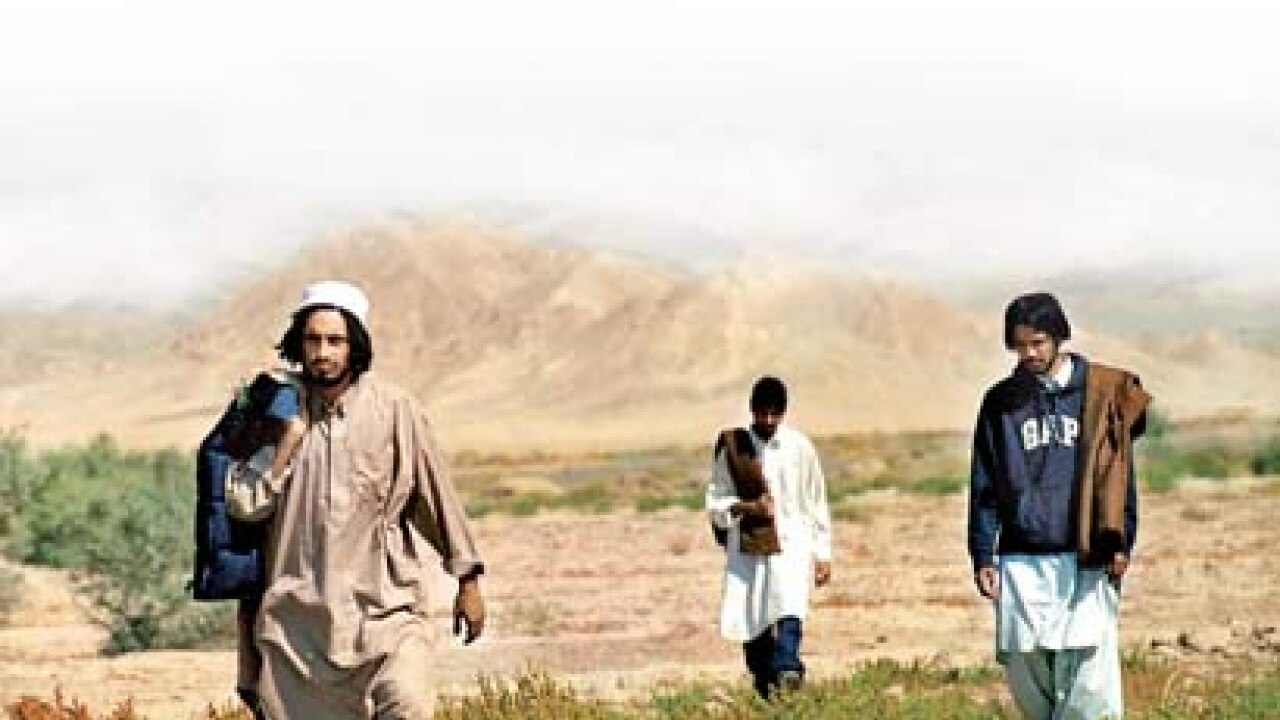
A group of children, none older than five, are busy mixing cement with water to build a bunker that would protect Afghan refugees from air attacks. A teacher hurries through the ruins, getting kids together and insisting they come to class immediately. “I’ll give you books,” she promises. Once assembled, she asks them, “Something big happened in the world. Who among you knows anything about it?” One kid volunteers: “Two men fell in the well; one of them broke his foot, the other died.” “Nope,” says another child. “They both died.”
Samira Makhmalbaf’s short film is a finely-crafted, sensitive take on responses to the 9/11 twin tower attacks from a part of the world no one really bothered to get reactions from: Afghanistan. “I wanted it to be innocent, from the eyes of the children,” said the celebrated Iranian filmmaker of her short, that is part of an anthology film called 11’09”01 September 11. Eleven filmmakers from different parts of the world — Alejandro González Iñárritu and Mira Nair among them — joined hands on the series of eleven short films, each of which reflects the impact of the 9/11 attacks on the world.
“These films were about people; they focused on different characters and how they were affected. There was a relatability factor,” says Anil Zankar, former professor of film appreciation at the Film and Television Institute of India (FTII). Zankar feels 11’09”01 September 11 was among the best films made in the aftermath of the attack, because it gave a perspective that was ‘un-American’, but which existed nonetheless. “Most 9/11 films coming out of the US are rather simplistic; they offer a micro view without really exploring different points of view.” Zankar singles out Michael Moore's acclaimed documentary Fahrenheit 9/11 as an exception.
Fahrenheit 9/11 brought to light facets, which Americans, and the rest of the world, knew little about at the time. Establishing the connection between the Bush family and that of Osama Bin Laden, the film took a critical stance on America invading Afghanistan and about the political games played to gain control of the oil market. “It gave a very real account of things, without resorting to propaganda,” says film critic Indu Mirani.
Hollywood sticks to propaganda
Hollywood, in typical style, has sold many a blockbuster in the guise of 'war' films, without really delving deeper. Katherine Bigelow's The Hurt Locker, about the lives of American soldiers in post-9/11 Iraq, was criticised by war veterans for its unreal depiction, and for glorifying violence. But it went on to win Best Film at the Oscars. The same year, Matt Damon-starrer Green Zone narrated a similar story, but not without squarely blaming the US government for the mess. Conveniently, the film was ignored at the award ceremony.
“The Hurt Locker is as formulaic as a Hollywood film can get; it is propaganda camouflaged as cinema,” says filmmaker Abhishek Sharma. “Similarly, a film like United 93 (about the heroic efforts of passengers stuck on the plane) gives you a one-sided view,” says the writer-director of the critically-acclaimed Tere Bin Laden, about a Pakistani journalist who creates an Osama video using a look-alike.
Another offshoot was the typecasting of Muslims in films made after. “During the Cold War, Hollywood villains were usually Russian, which later became Japanese/Chinese as the two countries became massive economic competitors. In the last 10 years, most terrorists in films have been Muslims,” says Zankar, citing the example of Body Of Lies. “Even in a film like The Kite Runner, you can't miss the generalisations,” adds Sharma.
Other voices that ring true
Films from other parts of the world, however, tried to narrate different stories. Apart from 11’09”01 September 11, Pakistani filmmaker Shoaib Mansoor’s Khuda Kay Liye and British filmmaker Michael Winterbottom’s The Road to Guantanamo (TRTG) have brought alternative point of views to celluloid.
TRTG narrated the story of ‘The Tipton Three’, of Pakistani and Bangladeshi origin from Tipton in UK, who were imprisoned by US authorities at Guantanamo Bay and released two years later without any charges against them.
Khuda Kay Liye focused on racial profiling among Muslims in the US, and criticised mushrooming terrorist camps in Pakistan. “The film showed both sides of the coin — the wronged Muslim facing racial profiling, as well as the wrong Muslim perpetrating hate among gullible kids,” says Mirani. “Few films wage a debate as well as Khuda Kay Liye did,” says Sharma.
Interestingly, an American film that presented audiences with an alternative view of the reasons behind the 9/11 attacks didn’t get a release in US theatres but gained massive popularity over the internet. You may say Zeitgeist: The Movie is utter nonsense. But the film, which claims the US government masterminded the 9/11 attacks, made for compelling viewing. The docu-drama says that the WTC buildings were brought down by controlled demolitions from within, orchestrated by people on the inside. “Zeitgeist, like all conspiracy theory films, is fun to watch, even though the message has to be taken with a pinch of salt,” says Sharma.
But irrespective of quality, or the filmmaker's intentions, cinema acts as a reminder of the event that shocked the world on this day 10 years ago. Chances are that films about life after 9/11 will continue getting made. After all, there are so many stories still left to be told.